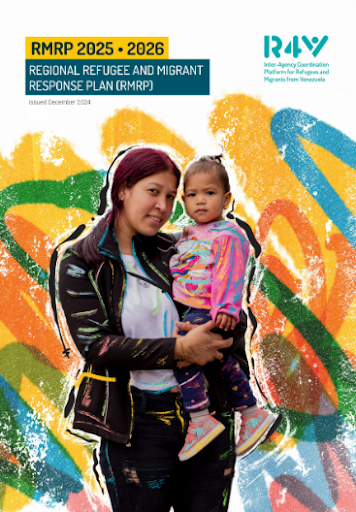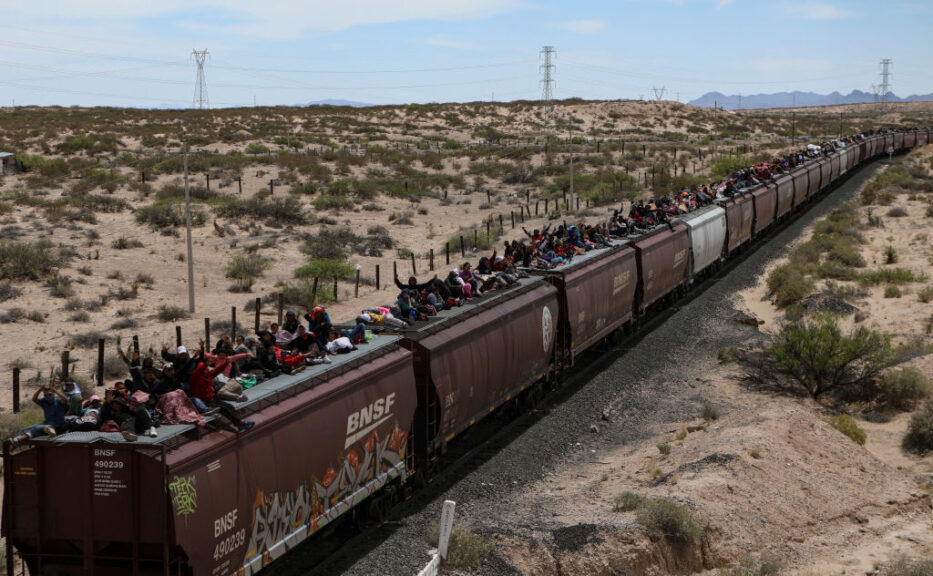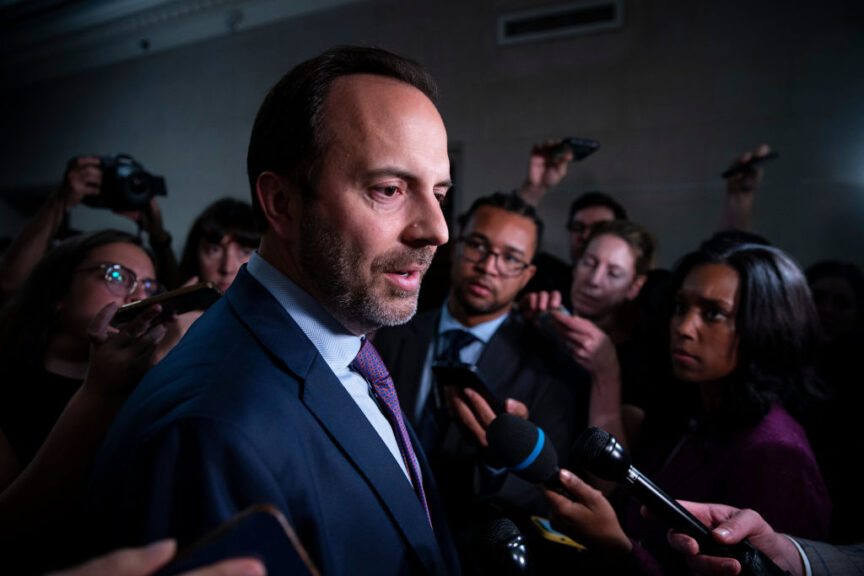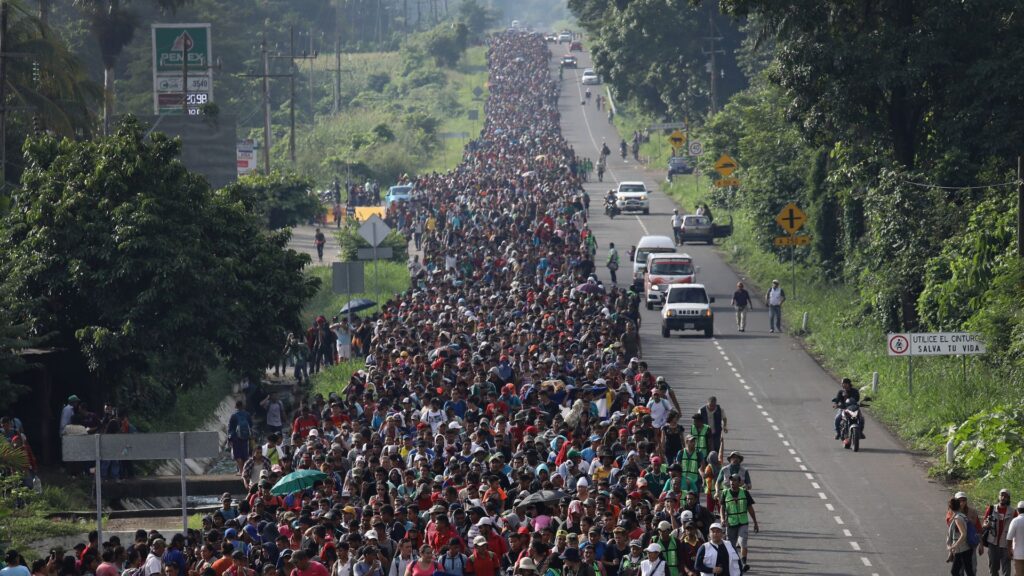As Trump 2.0 Approaches, NGOs Continue To Fund Mass Migration With U.S. Tax Dollars
AUSTIN, Texas – The large, organized constellation of United Nations and nongovernmental organization (NGO) agencies sees a rosy future for itself even under Donald Trump, having already directed billions of mostly U.S. taxpayer dollars into supporting millions of illegal southern border crossing trips during President Joe Biden’s term.
Perhaps, in part, to keep the migratory pressure on America’s southern border, using U.S. taxpayer money, as Trump mounts a planned border crackdown this year.
The U.N.-organized conglomerate recently released its 2025-2026 “Regional Refugee and Migrant Response Plan (RMRP),” which is a budget needs analysis for Latin America migration support developed during the U.S. presidential campaign but recognizes in its published iteration that Trump was re-elected.

Credit: r4v.info/en
The document calls for maintaining spending levels as high as when a mass migration torrent was at full throttle in recent years. It wants $1.4 billion to support 2.3 million foreign nationals from throughout the world who will be on the move toward the U.S. southern border through 17 Latin American countries, and $1.2 billion in 2026. That’s down from 2024’s $1.6 billion and 2023’s $1.72 billion.
The 14 U.N. and 230 NGO agencies (a list of these agencies can be found on page 434) will use the funding in 2025 to support 14 different forms of migration or refugee assistance in the hemisphere, including, for instance, $259 million in “cash, voucher assistance and multi-purpose cash assistance” to 390,000 foreign nationals during 2025. That money will be dished out as rechargeable cash debit cards, “cash in envelopes,” bank transfers, and mobile transfers for whatever migrants might need on the road.
They also call for $134 million in food provisions for 851,600 people, $13.5 million in “humanitarian transportation” to 94,800 foreign nationals, $297 million to 735,000 people for shelter such as hotels and longer-term rental properties, $150 million in health services to 1.4 million people, and millions more for a half dozen other kinds of migration needs on the trails.

Credit: Todd Bensman
Spearheaded in 2019 by the United Nations High Commissioner for Refugees (UNHCR) and the U.N. International Organization for Migration (IOM), which receive the bulk of their money from the United States, the coordinated RMRP migration support effort initially started to meet the needs of more than seven million Venezuelans who emigrated out of their failing home country. But RMRP planning documents openly acknowledge mission creep to support migrants of all “other nationalities…engaging in transit and onward movements” to the U.S. southern border. In 2023, the U.S. contributed $1.9 billion to the UNHCR, compared to a mere $377 million in 2019.

Credit: r4v.info/en
The new document notes Trump’s reelection but does not explicitly discuss its 2025-2026 needs in conjunction with Trump’s plans to immediately halt more than three years of an illegal immigration border surge that The New York Times recently concluded in an analysis was the “largest in U.S. history” and was directly caused by “President Biden’s welcoming immigration policy during his first three years in office.”
The group’s chief U.N. bureaucrat makes an oblique reference to a new negativity in “receiving nations” without naming the United States.
“It is essential to change the narrative that underscores the prevalent negative conception of migration agendas as only a source of problems and difficulties and keep striving for bringing to the fore the positive narrative of the contributions they can provide to receiving communities,” wrote Eduardo Stein, the UN’s Joint Special Representative for Venezuelan Refugees and Migrants in the document’s introduction.
Left unsaid is exactly how the U.N. and NGOs proposing these large ongoing expenditures really view them in light of the anticipated reduction in migration flows expected after Trump’s January 20, 2025 inauguration, when his “detain-and-expel” policies quickly replace Biden’s incentivizing catch-and-release policies.
Already, just the prospect of a Trump administration has vastly reduced international migration flows by more than 40 percent through the Colombia-Panama Darien Gap, while many immigrants in Mexico say they’ll return to their home countries.
The omission of straightforward references to the coming U.S. political pivot on illegal immigration suggests that the group likely assumes funding would be used to sustain migrants while Trump policies compel them to wait in third countries, perhaps waiting for – or even facilitating – Trump policy failure or for a future friendlier U.S. presidency.
HERIKA MARTINEZ/AFP via Getty Images
Regardless of U.N. intent, in the meantime, a potential – even probable – consequence of this continuing level of migration trail support would be to sustain steady pressure on Trump’s border for at least the next two years, perhaps even enough to induce policy failure.
The document seems to suggest some money might fund legal and propaganda operations.
For instance, one activity the group promotes as a high priority is to provide $204 million toward “protection,” topping the list is “legal assistance and counseling” that can counter a regional “shift towards more restrictive and security-focused approaches of managing migration and asylum…,” the document notes on page 77 in a category section titled “Protection.”
The legal assistance and counseling will, it says, reduce risks related to migrant returns to home countries that their advocates would argue were too dangerous, known as “refoulment,” as well as “deportations, and arbitrary and prolonged detentions.” The group will call on academics and human rights organizations in migration trail nations “to ensure visibility of key protection issues affecting refugees and migrants in the region.” Those might include countries the Trump administration plans to diplomatically coerce into helping slow flows.
A Point Of Contention And Potential Republican Action
In recent years, the UN-led conglomerate’s migration support efforts along the migration trails have become politically controversial because of the record-smashing traffic flows, especially among Trump supporters and some hardline border security-minded Republican lawmakers. Some saw the U.S. tax money funding the program as driving a self-destructive mass migration crisis that broadly damaged American national interests and advocated that U.S. money for that be pared back.
Republican lawmakers such as Texas Rep. Lance Gooden even filed a bill to defund the U.N. of U.S. donations, which did not advance when congressional chambers were split between Republicans and Democrats.
Representative Lance Gooden. Photographer: Al Drago/Bloomberg via Getty Images
But with the trifecta of a White House and both chambers of Congress in Republican hands as of January 20, the prospects for some kind of funding rollback for this kind of U.N. and NGO support seem more likely. Rep. Gooden told The Daily Wire he would try again under the more favorable new circumstances.
“Under the Biden administration, U.S. dollars are being funneled through the United Nation’s IOM into programs that facilitate and encourage illegal migration into our own country,” Rep. Gooden told The Daily Wire for this report. “I will work with President Trump to ensure that no one cent of American money supports the erosion of our sovereignty. We will end this taxpayer funded invasion.”
JOIN THE MOVEMENT IN ’25 WITH 25% OFF DAILYWIRE+ ANNUAL MEMBERSHIPS WITH CODE DW25
Dr. Nayla Rush, Senior Researcher at the Center for Immigration and a refugee policy expert, noted that the IOM and UNHCR mission is to assist migrants and refugees in need wherever they are. But as their top funder, the United States has a right to ensure neither organization is encouraging or guiding migrants to illegally enter the United States or submit false asylum claims.
“The U.S. government should ask for complete transparency and accountability as to where and how both organizations spend US taxpayer money.”
Creating Migration Pressure On Trump Or Reducing Suffering?
In early 2022, UNHCR spokeswoman for Mexico Silvia Garduno explainedthat her agency does not look for or consider evidence of illegal immigration but, rather, regards individuals it helps who are moving through as “vulnerable asylum seekers.”
“UNHCR assistance is based strictly on the humanitarian need of individuals in need of international protection,” she said. “UNHRC supports the authorities by providing individuals information on the right to seek asylum and assists individuals while their asylum applications are in process by, for example, referring them to shelters operated by civil society, providing legal assistance, or providing humanitarian support for food and basic needs for the most vulnerable.
(Photo by John Moore/Getty Images)
But the group’s own document repeatedly acknowledges knowing that those it helps are moving ever forward over international borders without authorization.
The group is clearly not planning any retreat.
When it started operations in 2019, the conglomerate provided its aid via a network of ad hoc way-stations along known smuggling routes from South America to the northern U.S.-Mexico border.
In recent years, however, the U.N. group has plowed investment funds into large multi-purpose structures like a 75,000-square-foot mega-mall just built in Tapachula, Mexico just north of the Guatemala border.
The UNHCR, IOM, and dozens of private often religion-based NGOs scattered around Tapachula, will work alongside one another under one massive roof here – evidently planning a years-long collaboration.

